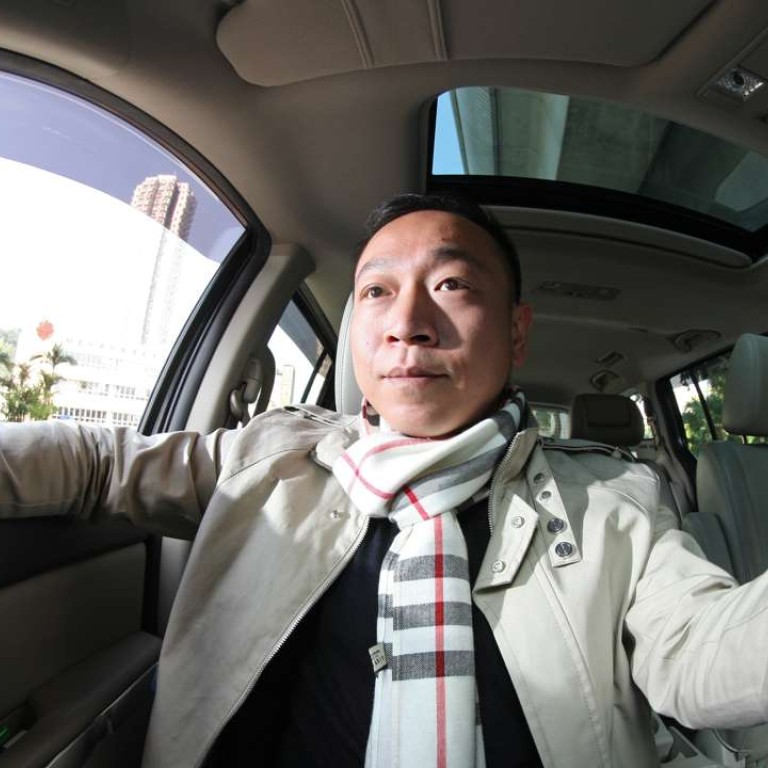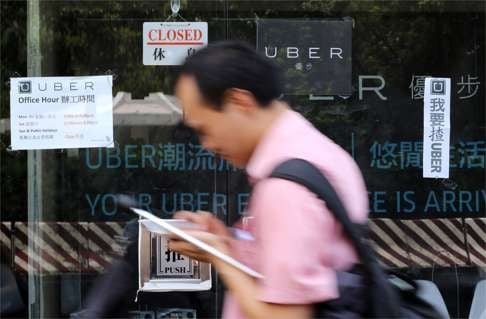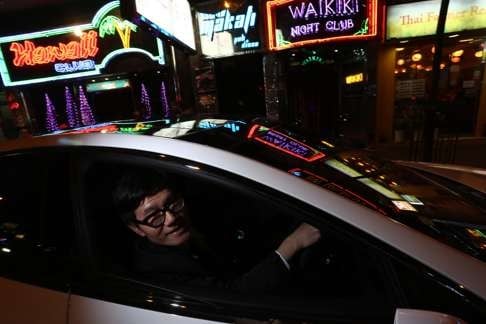
What’s it like to work for Uber? Hong Kong drivers tell the human story behind the ride-sharing app
It’s not just about the money – working for the multinational start-up hated by taxi drivers allows Hongkongers flexible hours and the chance to meet new people and make new friends
William Wong Ka-lok runs a business supplying takeaway ingredients for hot pots. He manages the operation from home in Sha Tin, with the food prepared at a premises in Kwai Chung. Six months ago, he started working as an Uber driver on the side.
Wong, 38, appreciates the flexibility of his part-time work and the extra HK$17,000 that it brings in each month.
“I used to be a bus driver, and could not take time off during festivals such as Lunar New Year. But I don’t have to sacrifice family time during festivals working for Uber. I can join my friends’ gatherings whenever I want to,” he says. “On the days that I’m free for driving, I just switch on the app.”
He also enjoys the fortuitous encounters from ferrying people in his MPV, a Mazda 8, a few of whom have become regulars.
“Some women have become friends, who share their romantic troubles with me on the rides.”

Uber pitched itself as a luxury ride-hailing platform when it launched in Hong Kong two years ago with its Black service. In December, the company introduced its lower cost UberX service aimed at a mass market, which has boosted its stable of drivers although it will not reveal any numbers.
Uber gave us assurance, saying they bought global third-party insurance and would provide full legal assistance if anything happens to the drivers
UberX offers a competitive fare package, putting even greater pressure on conventional taxis, which are already feeling the heat from UberBlack. Urban taxis charge HK$8 per kilometre on short rides, with a minimum fare of HK$22. UberX charges HK$6 per kilometre travelled and HK$1 for every minute of the ride, with a HK$30 minimum fare.
However, car-hailing services such as Uber are steering through uncharted legal areas in many cities, including Hong Kong. Seven Uber drivers were arrested in August and charged with using a car for hire without a permit and driving without third-party insurance, while police raided the company’s offices following complaints by local taxi drivers.

The crackdown has made drivers such as Timmy Cheng Tak-tim a little nervous.
“I am a bit worried by the court cases. But after the drivers’ arrest, Uber gave us assurance, saying they bought global third-party insurance and would provide full legal assistance if anything happens to the drivers,” Cheng says. “I will pay attention to how the court cases progress. If there’s a conviction, many drivers will quit for sure.”
Where you park your car affects business a lot. In Tsim Sha Tsui, one of the best places to wait is Man Cheong Street
(In January two drivers admitted to providing illegal car hire and were fined HK$7,000, with their driving licenses suspended for 12 months. The other five pleaded not guilty and their cases were adjourned to later this month.)
READ MORE: Five Uber drivers arrested in Hong Kong sting on unlicensed car-hailing services
A logistics manager, Cheng began driving with Uber about five months ago on Fridays and weekends. That means less time with family and friends, but he reckons the rewards are worth it.
Normally a car is a depreciating asset and a drain on his wallet with payments for parking and petrol, Cheng says, but Uber enables him to use his vehicle as an income-generating tool.
He makes at least HK$15,000 per month from driving after deducting for costs, and “the extra money can help pay for my children’s education”, says Cheng, 45.
“The driving experience is also enjoyable. I can meet people from all walks of life, and drive to places I have never been to before,” he says, recalling how one fare took him to Lung Ha Wan, a pleasant cove at the north end of Clearwater Bay Country Park.
Cheng made new friends among his passengers, including a lawyer who he consults for legal advice and a travel agent, who tips him on the best places to wait for tourists.
“Where you park your car affects business a lot,” he adds. “In Tsim Sha Tsui, one of the best places to wait is Man Cheong Street. From there, you will be connected to passengers in Olympian City, the ICC and Elements mall.”
Cheng enjoys the driving job so much that he recently invested in a HK$770,000 Tesla electric car to reduce his fuel costs.
“Petrol was my biggest expense in driving for Uber. With the Tesla, I can enjoy free parking in public housing estates,” he says, adding that the savings from the switch is enough to cover his monthly instalments on the electric car.

A rare woman among the Uber corps, Rita Lo says she joined the service because “my husband wanted to earn the HK$1,500 fee from Uber for introducing a new driver”.
But she enjoys being behind the wheel and her job as an insurance agent is sufficiently flexible that she can juggle family and another part-time job – Lo only takes fares in the morning because she has to ferry her two children home from school.
Wheelchair-bound passengers are glad to see me after [encountering] taxi drivers who just drive away at the sight of their chairs
The 42-year-old says chatting with the professionals she meets, such as social workers, lawyers and investment consultants on rides, expands her horizons.
“They tell me the inner workings of their industries. I find it interesting as I don’t hear about such things in my social circle.”
READ MORE: Hongkongers overwhelmingly prefer Uber over taxis in wake of government crackdown: survey
A member of Uber’s Assist team, Lo has received training to help disabled and elderly passengers. “I have learnt some basic sign language, and served the blind, the deaf and the physically disabled,” she says. “Wheelchair-bound passengers are glad to see me after [encountering] taxi drivers who just drive away at the sight of their chairs.”
For retirees such as Francis Lau, the income from driving for Uber means he does not have to keep dipping into his savings. He drives three days a week and says he enjoys talking to foreign passengers about their cultures.
“After I started working as a Uber driver, I stopped taking taxis, too. After dinner gatherings where I drink, I will just call Uber.”
But even Uber faces competition from new car-hailing and car-pool services.
Among the new entrants is Cetah, an operation launched in February by former mobile games developer Fung Kam-keung.
The home-grown service describes itself as offering “free rides” to passengers, who will “tip” their drivers on arrival, with the amount based on the quality of service.
Cetah, which says it has registered 2,000 drivers, claims the model will not contravene Hong Kong law as it does not constitute carrying passengers for money.
Not only are we losing passengers, we are losing drivers, too. People with their own cars would rather be Uber drivers as they wouldn’t have to pay HK$500 per day to lease a taxi
Ryde, a real-time car-pool service developed in Singapore, is set to roll out in Hong Kong in the second quarter of this year. Linking users through an app, it allows commuters travelling along the route to share a ride.
Whereas Uber fare payments are split 25/75 between the company and driver, passengers and drivers using Ryde are expected to decide on the fare between themselves. Instead of taking a cut of the fare, Ryde will simply charge users an annual membership fee of HK$150. The service has signed up 30,000 members since it launched in Singapore last year and aims to attract 50,000 users in its first year in Hong Kong.

As more people switch to car-hailing ventures, the cost of an urban taxi licence has dropped from HK$7.2 million last year to under HK$6 million, with New Territories licences falling from HK$6 million to less than HK$5 million.
Beleaguered cab drivers have filed police complaints and staged “go-slow” drives and demonstrations in protest.
The chairman of the Taxi Association Federation, Choi Keung, wants the government to clear up the legal position regarding hire of private cars for carrying passengers.
“Not only are we losing passengers, we are losing drivers, too. People with their own cars would rather be Uber drivers as they wouldn’t have to pay HK$500 per day to lease a taxi. We are trying hard to improve the image of taxi drivers [due to] some bad sheep who serve passengers selectively and take detours [to a destination].”

The murky legal status of Uber has put government organisations such as InvestHK in a delicate position. InvestHK initially praised the service for offering greater choice for commuters and more opportunities for drivers on its website, but deleted references to the operation on its website after the arrests in August last year.
In January, InvestHK’s director-general of investment promotion, Simon Galpin, told the media that all companies, including global ventures such as Uber, had a responsibility to comply with Hong Kong law.
Even Singapore, a country that has strict regulations on the transport industry, has adjusted its laws to accommodate Uber. Hong Kong is narrow-minded in suppressing it
Responding to a query last month about Uber, the head of the new Innovation and Technology Bureau, Nicholas Yang Wei-hsiung, described the private venture, valued at US$62.5 billion, as a company that uses big data. He urged Hongkongers to pay attention instead to local start-ups built on big data such as GoGoVan, now worth HK$780 million.
“Hong Kong’s public transport system is very convenient. I believe that the law is not the reason for the operational difficulties of such car-hailing platforms. There are good and bad technologies. Not all are good and we need to strike a balance.
“The government has a responsibility to protect customers and regulate the [transport] sector when the need arises…. The government will not change the law just for the sake of one new technology.”
However, Francis Fong Po-kiu, president of the Hong Kong Information Technology Federation, reckons Hong Kong regulators are behind the times.
“Even Singapore, a country that has strict regulations on the transport industry, has adjusted its laws to accommodate Uber. Hong Kong is narrow-minded in suppressing it,” he says.
“It’s common knowledge that some Hong Kong laws cannot catch up [with advances in technology]. Deterring such innovations from operating their businesses will undermine the confidence of investors. Uber has proved to be a positive force, forcing the taxi industry to clean up its act.
“If Uber’s claim to have bought global third-party insurance is true, they should be allowed to operate. “

For Joe Leung, 44, however, it is the cool factor that led him to quit his job as a bodyguard to become a full-time Uber driver.
“I thought of becoming a taxi driver but dropped the idea after hearing about Uber. The setting is more casual in a Uber car. The idea of sharing resources which are otherwise not utilised has more meaning than taxi rides which are just business transactions.”

